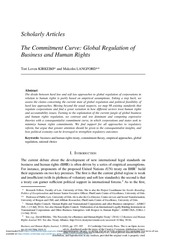The commitment curve: Global regulation of business and human rights
Peer reviewed, Journal article
Published version

View/
Date
2018-07Metadata
Show full item recordCollections
Original version
https://doi.org/10.1017/bhj.2018.11Abstract
The divide between hard law and soft law approaches to global regulation of corporations in relation to human rights is partly based on empirical assumptions. Taking a step back, we assess the claims concerning the current state of global regulation and political feasibility of hard law approaches. Moving beyond the usual suspects, we map 98 existing standards that regulate corporations and find a great variation in how different sectors treat human rights and accountability issues. Turning to the explanation of the current jungle of global business and human rights regulation, we contrast and test dominant and competing expressive theories with a consequentialist commitment curve, in which corporations and states seek to minimize human rights commitments. We find support for all approaches to regulatory reform, but argue that greater attention should be given to the consequentialist insights, and how political economy can be leveraged to strengthen regulatory outcomes.
